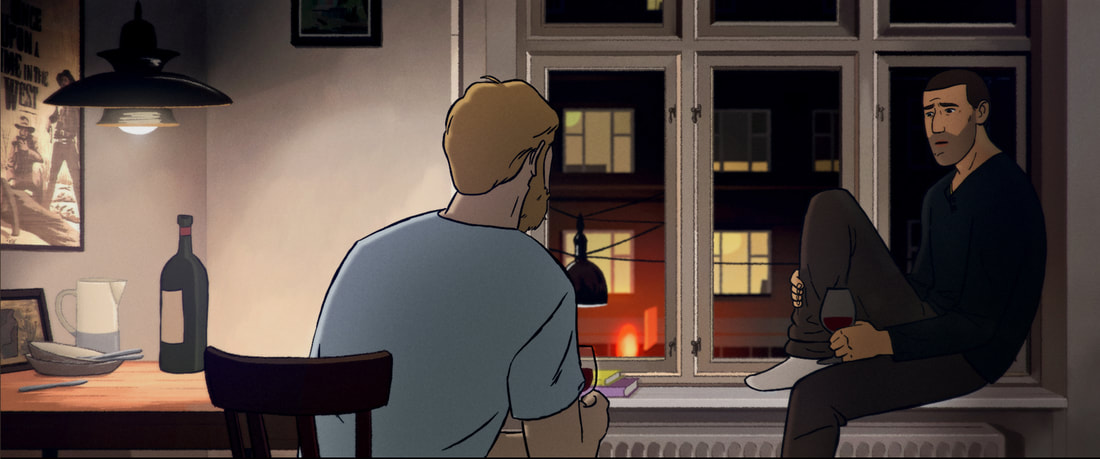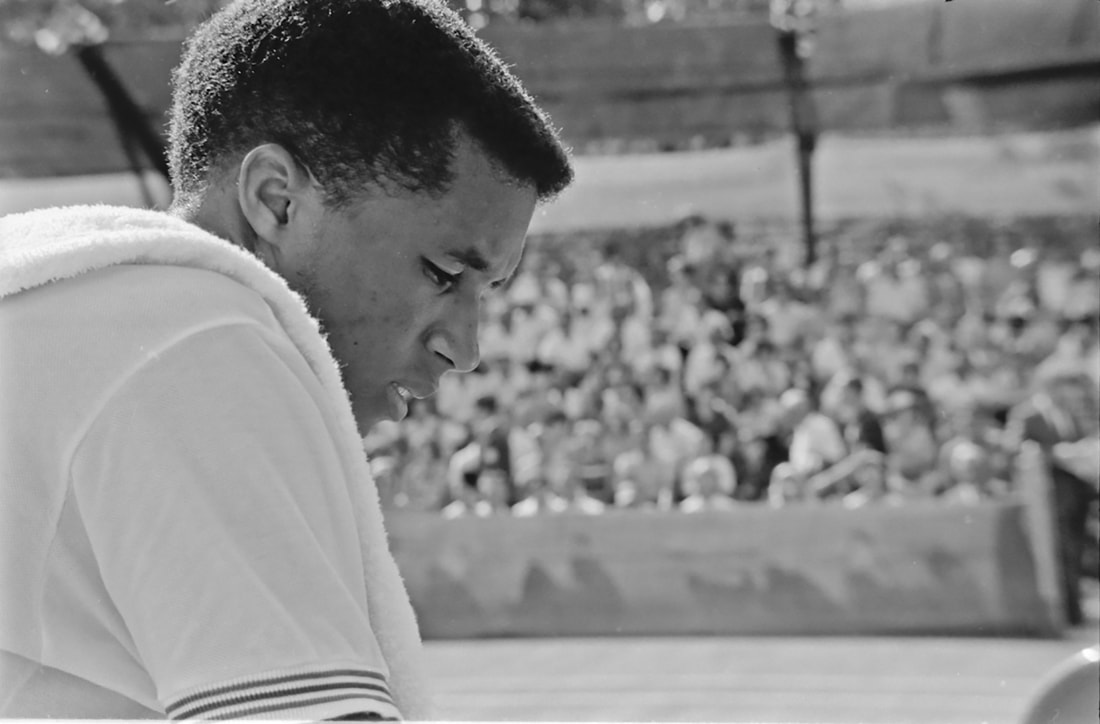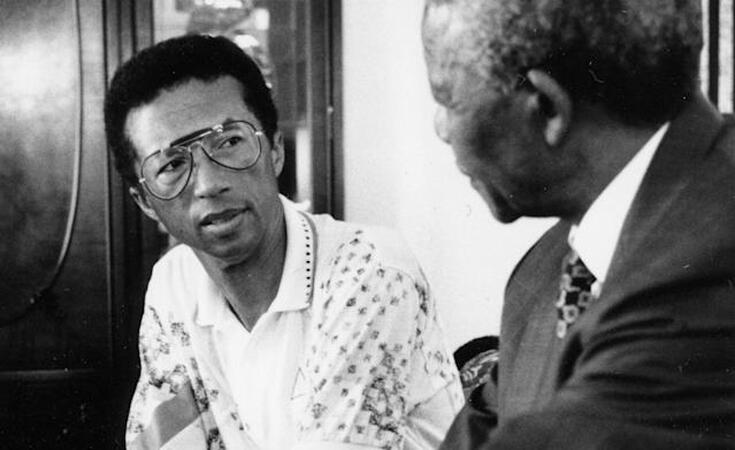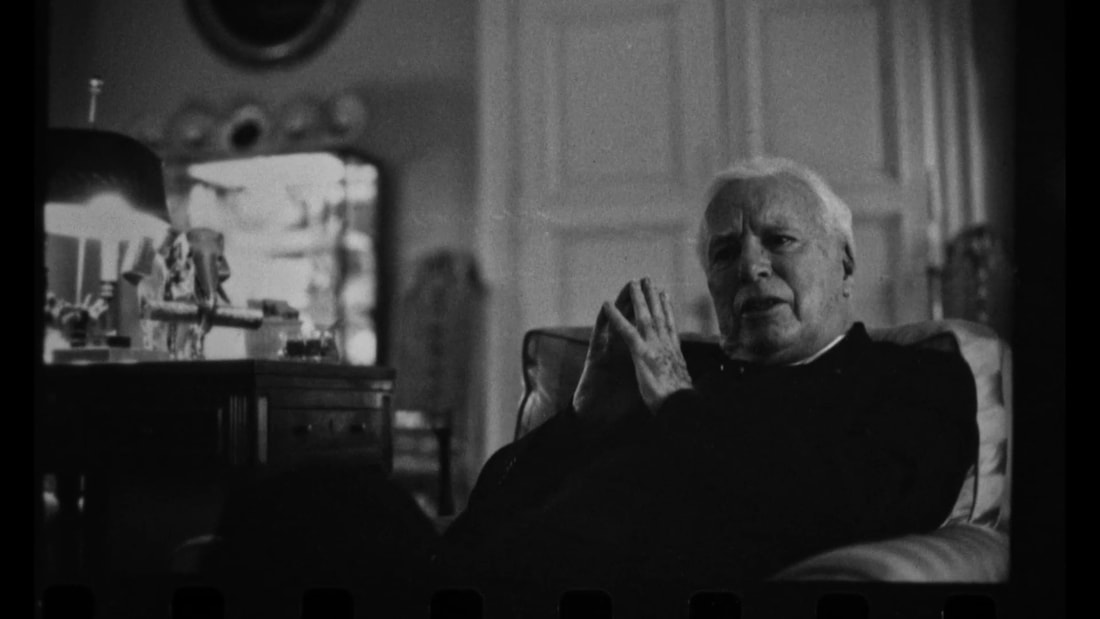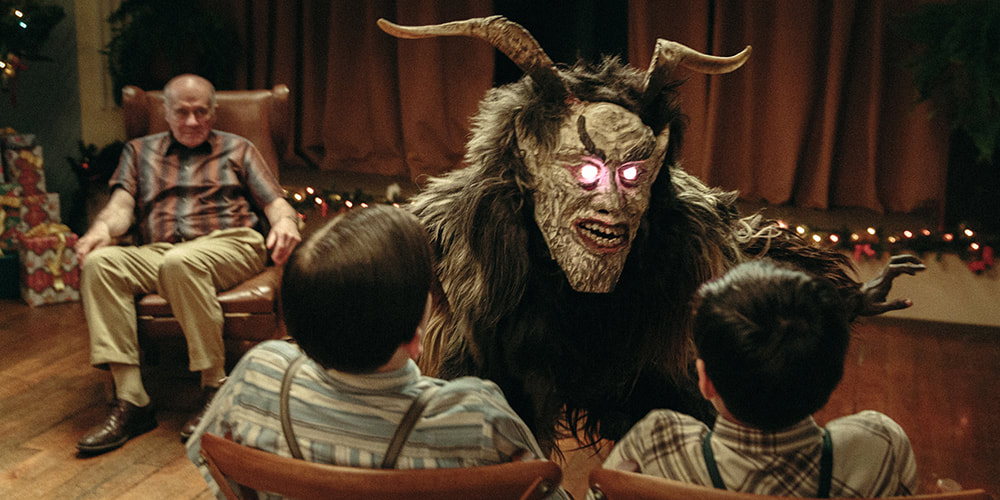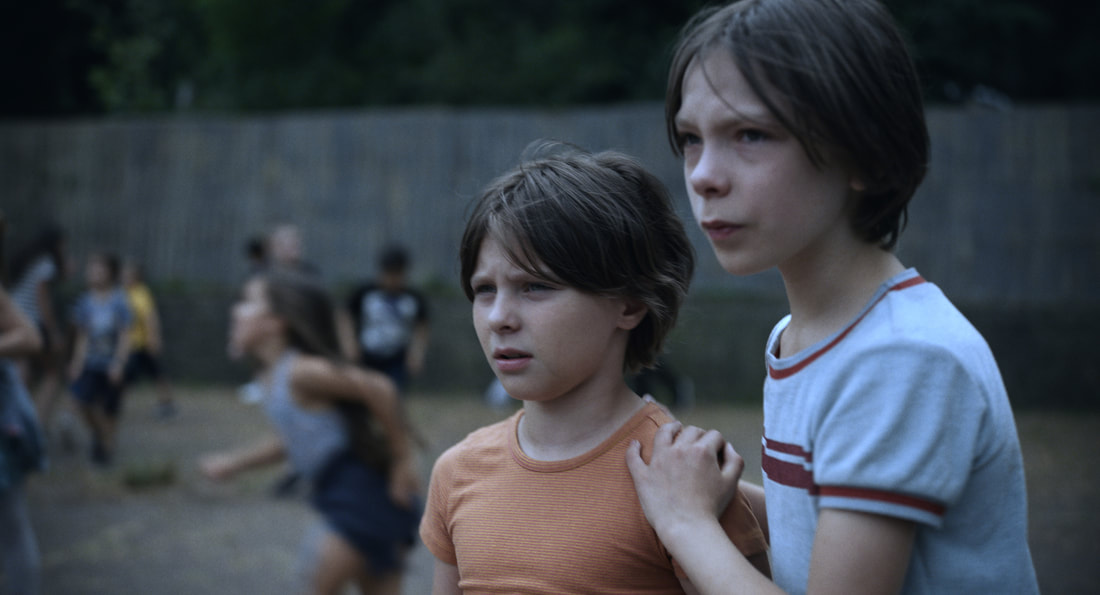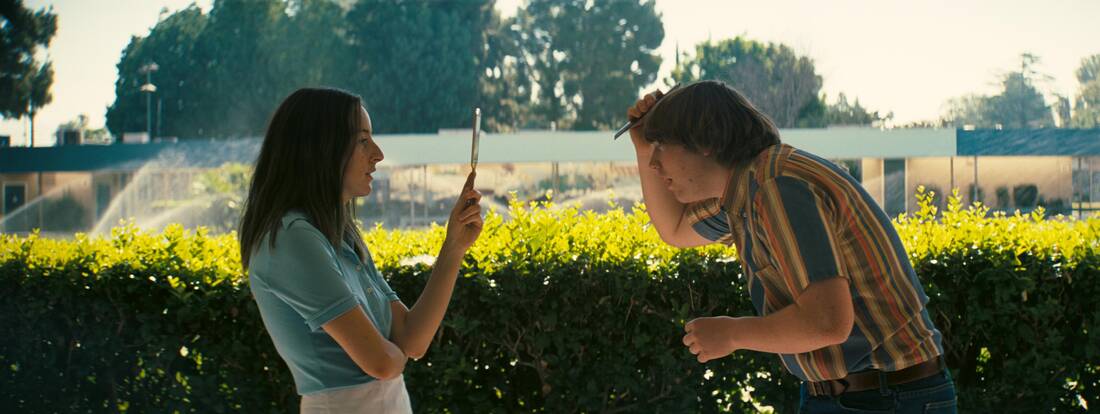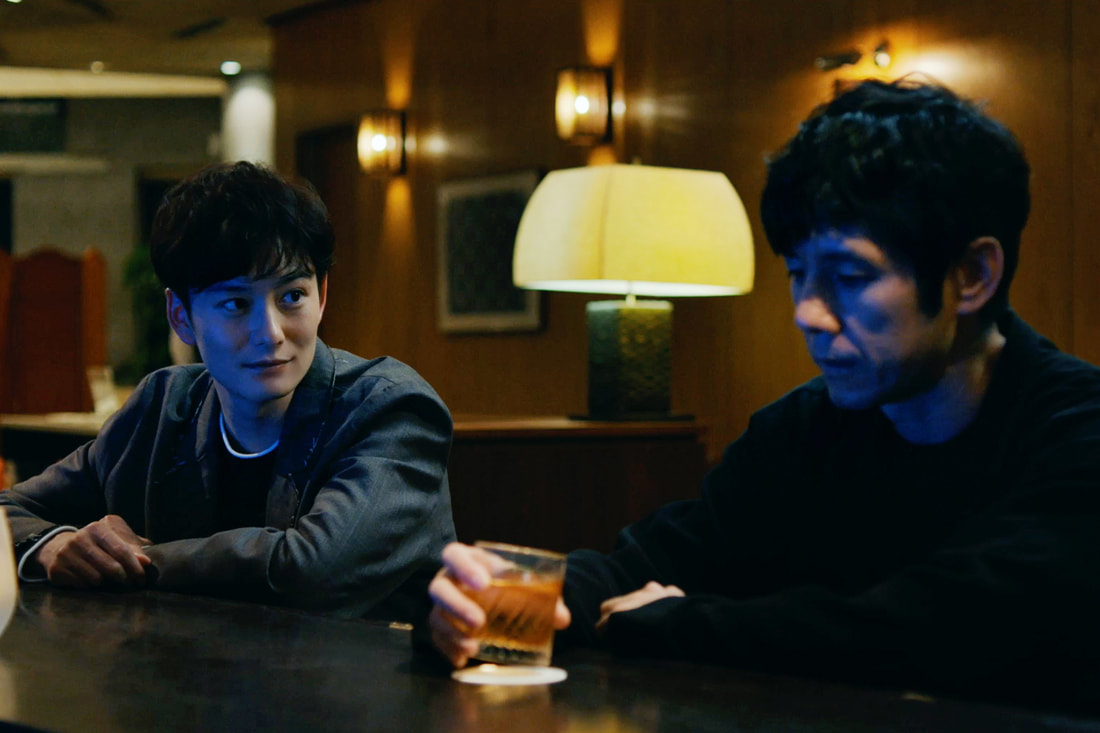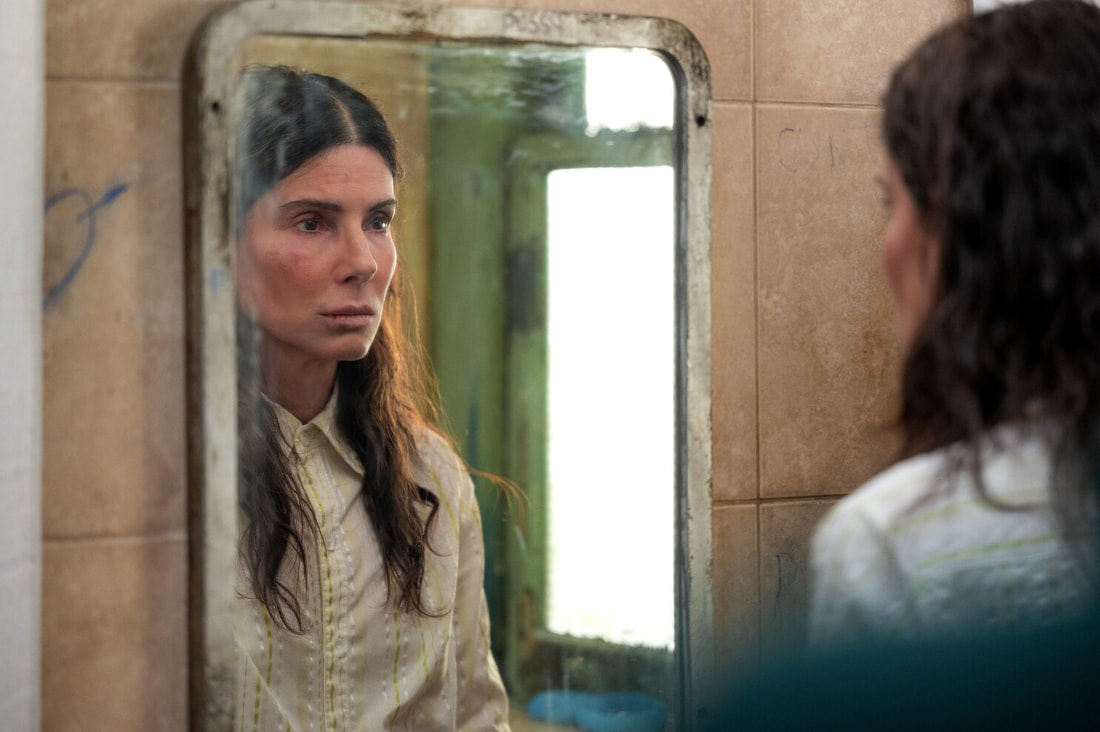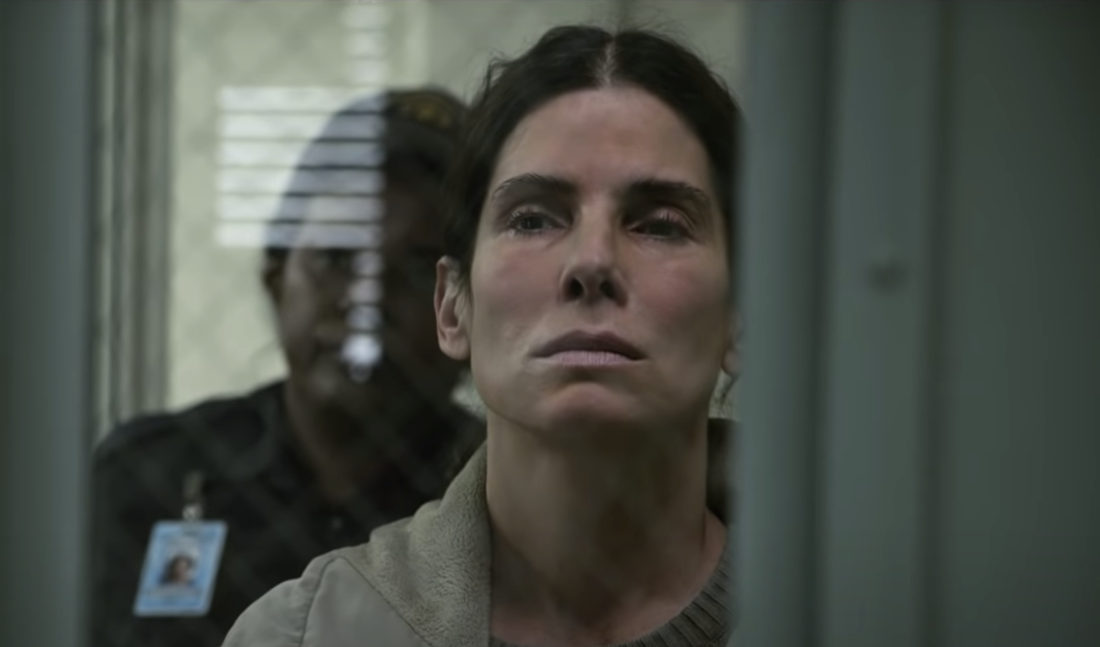|
Review by Dan Skip Allen
Flee is one of those rare films that checks a lot of awards season boxes. It's a documentary, an animated film, and a foreign film. The thing is this film could be checking the biggest box when it gets nominated for Best Picture at next year's Academy Awards. It's worthy of many other nominations in many other categories as well.
Flee tells the story of a man who is giving an interview to another man, a documentarian, about his family's harrowing journey of escape from war-torn Afghanistan following the exodus of the Soviet Union from the country in the late '80s and early '90s. The escape involved separating the family and going to and from a few different countries including a period in Russia. These people go through quite an ordeal, from being almost drowned in a boat to being under constant scrutiny from the Russian police and also being captured at one point and sent back to Russia. This film was very good at describing these scenes very vividly. That aspect of the film worked very well. The Danish subtitles were fine as well. They didn't move too fast. They were easy to read. The animation style leaves something to be desired. Even though this is an animated film doesn't mean it's very good. The story and narrative of the film extend toward the overall animation. I feel they wanted to get the documentary aspects correct and that made the animation not as important. It's not anything groundbreaking like Pixar or Disney animation, but it's serviceable regarding the overall context of the film.
As far as documentaries go, this is a great one because of all the different styles involved in making the film. The director, Jonas Poher Rasmussen, used some archival footage and photos to help show the people and places in the film. Amin, the main character, decided to be a bit deliberate in telling his story so the editing of him talking about his family's story was very effective to fit this into the ninety minute run time. It could have gone longer.
Flee premiered at the 2021 Sundance virtual film festival this past January. It was widely beloved by critics who saw it back then. That led NEON, the studio that brought Parasite to an Academy Award for Best Picture win in 2019, to pay the exorbitant amount of one million dollars for the North American distribution rights to the film. They are doing a great job of spreading the word of what an amazing film this is. These types of harrowing tales of survival are the kind of stories that need to be brought to the big screen. Executive Producers Riz Ahmed and producer Nikolaj Coster Waldau, among many others, got behind this film and they knew what they had. Even though this is the Danish submission for the Best International Feature, it is shared by many countries and many languages are spoken in it as well. It is a film the whole world can get behind. And they should. It's one of the best of the year. Flee hits theaters on December 3. Rating: 5/5
0 Comments
Review by Dan Skip Allen
The '60s were a tumultuous time for a lot of people of color, especially those in the South. Celebrities, singers, and athletes had a platform to make a change or fight for equality in those days. Arthur Ashe was one of those athletes that had a platform as a professional tennis player to speak up and speak out if he chose to.
As a younger man, Ashe showed what he could do on the tennis court. This got him seen by the tennis coach of UCLA and he offered Ashe a scholarship. This was like a life of freedom for him. He dated many women including white women. He enjoyed his time there in southern California. He then made a very important decision of joining the ROTC and ended up in the Army. This started to make his life more difficult. When the death of Martin Luther King Jr. happened, this was a turning point for a lot of Black people in the country. That led to more killing at home and abroad in Vietnam. Ashe was at the center of this because of his beliefs. His tennis got in the way, though. This was his profession and the way he could speak on behalf of his fellow African American men and women. Winning matches and tournaments spoke volumes for Ashe and his message of equality. This film has a lot of different techniques used to make this film what it was. The archival footage of old tennis matches was very good to show his ability on the court. The photos showing various people in his life, as well as newspaper clippings, helped move the story of this and life forward. Talking heads filled in the blanks for the rest of the story. The filmmakers did a great job getting to the bottom of his life in this film.
Ashe's personality was that of a very meek and mild man, but within that, he would speak in a way that got what he wanted to say out. His stance on Apartheid in South Africa was very staunch and he was considered persona non grata in that country. He believed in Nelson Mandela and his mission to stop the mistreatment of Africans in that country. This wouldn't be the last of the stances he would take on civil rights.
His career on the court was very good, but his rival Jimmy Conners sued him for libel off the court for saying he was unpatriotic because he wouldn't play in Davis Cup or join the tennis union. This caused a rift between them and they didn't get along with one another. This all came to a head at the 1975 Wimbledon Tournament final, where these two tennis legends played a great match. This was a huge moment for Ashe and America. Tennis was on the front page of the newspapers and was a household word. This film showed what a leader and patriot Ashe was. His beliefs and battles he fought meant something to a lot of people as well as the game of tennis, which he loves and cares so much about. The film depicts this man and all his glory. The various ways the film was made to make a through-line to show this man's life was very good and effective. This documentary is another in a long line that gets to the bottom of a groundbreaking person in history. Ashe is that and this film tells his story very effectively. Citizen Ashe hits theaters and VOD on December 3. Rating: 4/5
Review by Sean Boelman
Charlie Chaplin is without a doubt one of the greatest entertainers to have ever lived, and so his career has been chronicled many times in documentary form. However, Peter Middleton and James Spinney do the seemingly impossible with The Real Charlie Chaplin, creating something legitimately unique.
The movie tells the story of the legendary comedic actor Charlie Chaplin, peeling back the curtain to reveal the truth avout who he actually was. The thing that makes Chaplin so special is that he was around for one of the biggest changes Hollywood has ever made — the transition from silent to sound film — and he was one of the rare people to be able to make that jump successfully. And as such, his story serves as an interesting case study into this period of change. Middleton and Spinney make the wise decision of not telling his story purely chronologically, thus avoiding the pitfalls of a traditional biography. Although the movie explores his life in rough order, the emphasis here is more on themes and ideas, giving the filmmakers the freedom to move around a bit if there is a purpose to it. The film does a very good job of exploring many of its themes, chief among them what it means to live in the spotlight. Middleton and Spinney dissect the public image of Chaplin in a very interesting way, and relate it to his very different private life. It’s this duality that is the focus of the movie.
One of the main benefits of this approach is that it really humanizes Chaplin. The documentary discusses how cinephiles often see Chaplin more as his famous characters than the person he was, but challenges the audience to see beyond the slapstick comedy to relate to him as a flawed individual.
The parts of the film which detail some of the more difficult portions of Chaplin’s life and career definitely have a significant emotional impact. It’s eye-opening to see a figure that is so universally beloved have such a tumultuous life behind the scenes, really putting it into perspective what we should value in life. For the most part, Middleton and Spinney build their movie up of archive footage and footage taken from Chaplin’s extensive filmography. It’s great to see some of this preserved footage, as it’s a great reminder as to why the world fell in love with Chaplin in the first place. There is also a narration, and while it isn’t bad, it is perhaps a tad unnecessary as the footage often speaks for itself. The Real Charlie Chaplin is a must-see documentary for all cinephiles because of the intimate insight it offers into one of the greatest movie stars who ever lived. There have been plenty of biographies about Chaplin, but this one stands out above the rest. The Real Charlie Chaplin is screening at the 2021 DOC NYC film festival, which runs November 10-28. Rating: 4.5/5
Review by Sean Boelman
The past decades have seen a surge in the quality of Latin American genre cinema, and the Chilean thriller A Place Called Dignity is the latest in a line of impressive outings. Playing out almost like a Latino take on a Yorgos Lanthimos film, sharp dialogue and unique character work allows this to be quite the unique movie.
The film follows a young boy who receives a scholarship to attend a mysterious and secluded private school, where he soon discovers the institution’s unorthodox and dangerous practices. It’s definitely a story we have seen before — a neophyte is inducted into a shadowy organization whose ways are outdated and everything comes crumbling down — but Matías Rojas Valencia’s style is what allows it to stand out. Valencia’s movie manages to feel both entirely compelling and somewhat overstuffed. There are a few subplots going on in the film in addition to the main storyline, and while they are all interesting, they feel too underdeveloped to make much of a difference. This time would have been much better utilized developing the main story deeper. The character development in the movie is certainly a bit on the typical side, but Valencia does a good job of making the protagonist compelling. The antagonists are definitely very exaggerated, but their over-the-top nature does a great job of creating a very menacing feeling over the course of the film. Something that is frustrating about the movie is that it doesn’t have much to say that is particularly unique. The film covers the same themes of assimilation and individuality that so many other movies like this have. Even the more culturally specific aspects of the film feel somewhat underwhelming. In terms of the cast, there really aren’t any standouts, but they function well as a cohesive unit. The dialogue of the movie is purposefully deadpan, and so it makes sense that a lot of the performances would be on the colder side, except of course the protagonist, who serves as the audience’s only real point of entry into the story. There are some really interesting things happening in Valencia’s style that allow this film to be as memorable as it is. In some of the more comedic scenes, there is a particular visual vocabulary which creates the right feeling of awkward humor. And the compositions throughout the entire movie are effectively sterile, building the tone well. A Place Called Dignity is definitely a unique specimen of a film, and while it does have too many moving parts for all of them to work, it’s still an interesting watch. Matías Rojas Valencia’s sophomore feature makes it clear that he is a talent to look out for. A Place Called Dignity screened at the 2021 Tallinn Black Nights Film Festival. Rating: 4/5
Review by Sean Boelman
Laura Wandel’s taut directorial debut Playground was selected as the Belgian submission for the Academy Award for Best International Film, and it is understandable why. Although the film is undeniably quite simple, there’s a certain power and relatability to be found in this morality study.
The movie follows a girl in primary school who finds herself torn between her allegiances when she witnesses her older brother be the victim of severe bullying. It’s the type of tragic story that we see happen way too often, and the fact that Wandel is calling attention to it is certainly very admirable. Clocking in at a mere seventy-two minutes, Wandel gets done what is necessary and then wraps everything up. She gets us invested in the story early on and keeps the tension and anxiety high. Even in the more mundane moments, Wandel manages to capture the fears one has in childhood quite well. Yet Wandel doesn’t take the easy way out when it comes to discussing her themes. It’s easy to point a finger at the bully and say that what they are doing is wrong, and that’s because it is. But the film really explores the larger impact that bullying has, particularly on people other than the victim, which is something that isn’t often discussed.
The character development is admittedly one of the weaker aspects of the movie. The protagonists are stand-ins for the average child, not given much of an individualistic personality of their own. And the brother/sister dynamic which is meant to be the emotional crux of the conflict feels somewhat underwritten.
That said, the acting in the film is definitely something special. Both young actors who play the leads bring an extraordinary amount of emotion to the table, likely because the story is so impactful and relatable. Maya Vanderbeque, in particular, commands the screen in a way that someone her age should not be able to. Wandel aims for a gritty style here, and it definitely pays off. The scenes of bullying play out in a way that makes them feel just as harrowing as watching an act of brutal violence, and that really helps get the main point across. Wandel is clearly trying to make her movie have the most guttural impact possible, and it works. Playground is a very effective film, accomplishing exactly what filmmaker Laura Wandel sets out to do. It may not be particularly ground-breaking, but it explores its difficult themes with an uncommon level of empathy. Playground screened at the 2021 Tallinn Black Nights Film Festival. Rating: 3.5/5
Review by Camden Ferrell
Christmas is many Americans favorite holiday, and Apple TV+ has a documentary about one extreme Christmas fanatic. ‘Twas the Fight Before Christmas is the second directorial effort from Becky Read. However, this film’s subject is radically different than her previous work. While this documentary has a wacky premise, it doesn’t have much substance, and it suffers significantly from wavering in its direction and execution.
Jeremy Morris is a lawyer in Northern Idaho, and like many people, he enjoys Christmas and decorating his home. Unlike most people, his decorations are beyond extravagant, featuring countless lights, choirs, and even a camel, becoming a community spectacle or eye sore depending on who you ask. However, his plans to inspire Christmas cheer are met with a notice that his event violates rules according to the HOA. From here, we see Morris do everything in his power to keep his lights on. In and of itself, this premise is interesting, and it has the benefit of exploring the legalese behind a conflict such as this. Despite having a great set up, the retelling of events leaves a lot to be desired. It does a decent job of giving the audience context, but it lacks originality, and it’s not as captivating as it could have been. The film also has an overreliance on talking heads. While they’re effective means of storytelling, this film used it as a crutch when it’s B-roll couldn’t do the job.
One of the main problems with the film is that it remains sporadically ambiguous on its opinions on Morris. This gets especially muddled when he starts arguing that he is suffering religious discrimination. It’s ridiculous, but it’s hard to tell whether the filmmakers are in agreement or are making fun of his actions. I imagine audiences might be split on their opinions of the subject, and it doesn’t help that the film can’t seem to make up its mind on the matter.
Many parts of this film feels so inflated, that it comes off like a fearmongering Fox News segment, and it undermines the true story at its core. While I admit the premise has an innate factor of intrigue, it’s a shame to see how the film doesn’t make the most of its opportunity. Love him or hate him, Morris has charisma, and it’s disappointing to see how the film doesn’t amount to much when there are some good things working in its favor. ‘Twas the Fight Before Christmas might be interesting to some audiences who want to see a silly battle between a Christmas-obsessed resident and the HOA. Unfortunately, some may also find its execution to be generic and uninspired throughout. ‘Twas the Fight Before Christmas is streaming on Apple TV+ November 26. Rating: 2.5/5 Reviewed by Adam Donato A Castle for Christmas is the latest in the onslaught on Christmas content coming out on Netflix this holiday season. This one sports two stars who have seen better days: Cary Elwes and Brooke Shields. The film is directed by Mary Lambert whose most notable feature is 1989’s Pet Sematary. Does this Netflix movie have the star power to make it feel like any more than a dime a dozen Hallmark Christmas movie? Shields plays Sophie Brown, a famous romance novelist who is being shredded by her fans for killing off the male romantic interest. She decides to get away from it all by taking a work trip out to Scotland so she can start writing her next project. After visiting a castle, she decides to buy it, but is confronted by the reluctant and stubborn Duke who is forced to sell his land. Now they’re stuck in the castle trying to outlast each other, but things get messy when they start to develop feelings for each other. Wow, this is one of the most cliche Christmas romances there is. Start off with a forced meet cute where they awkwardly fall into each other’s arms. He’s a Christmas Grinch and she’s going to steal his heart with the magic of Christmas. It’s sappy and cheesy content that the target demographic has seen a million times. That being said, this is some single mom’s favorite movie of the year for sure. She grew up watching Blue Lagoon and crushing on Westley from The Princess Bride. It’s the perfect movie for the type of movie casual whose standard for this movie is that it has romance and is about Christmas. Speaking of moms, the movie starts off with an odd cameo from Drew Barrymore. Sophie Brown makes an appearance on Barrymore’s real life talk show promoting her latest book. Barrymore chastises Sophie for killing the male love interest. Sophie responds by asserting her power over these characters insisting that she could kill him in a variety of different ways. Credit where credit is due, this is so over the top that it’s decently funny. The rest of the movie does not have this kind of energy. The special effects are hopefully a symptom of the low budget, but nobody is watching this for the effects. The cliche third act conflict is completely ridiculous and is resolved in the most insignificant way possible.
There’s an audience for this movie, but it’s certainly not anybody who takes film seriously in any capacity. It’s perfectly serviceable for what it is and it does help that the leads are a couple has-beens instead of two no name actors. This story has been told a million times and it’s not even a good one. Steer clear of this Christmas dud. A Castle for Christmas is now streaming on Netflix. Rating: 1/5
Review by Sean Boelman
Paul Thomas Anderson is one of the rare American filmmakers who is both a critical darling and an audience favorite. And his newest film, the coming-of-age comedy Licorice Pizza, is his most accessible movie in years, a hilarious and heartfelt ode to the Los Angeles of the 1970s which benefits from his unique voice.
The film follows a teenage boy who is a former child actor and currently a failed young entrepreneur as he befriends and forms a unique connection with an adult woman. It’s definitely a movie that deals more in vibes than plot, but the atmosphere that Anderson builds is so infectiously fun that the movie is endlessly charming. Anderson weaves through the different pieces of his story in a way that is somehow both relaxed and full of life. There are a lot of laugh-out-loud moments, and while there are a few scenes that will stand out to viewers more than others, these scenes are nicely distributed over the entire runtime to keep the audience interested. Although this definitely isn’t one of Anderson’s more important films in terms of themes, that doesn’t make it any less profound. Anderson offers some poetic observations about youth and growing up. He takes this very common arc and makes it into something refreshing by writing characters that are remarkably empathetic.
A big part of what makes this movie work so well is that the characters are very complex. Even though the two leads both frequently make frustrating decisions, it’s their flaws that makes them so endearing. And the film is also filled to the brim with bit parts based on or inspired by real Hollywood figures from the past.
Cooper Hoffman, the son of the late Philip Seymour Hoffman (a frequent collaborator of Anderson), does an exceptional job in his leading role, bringing a lot of charm to the character. Alana Haim is great opposite him, commanding the screen and sometimes even stealing his thunder. And Bradley Cooper has an extremely memorable cameo resulting in one of the funniest scenes in any movie this year. Anderson is one of the few filmmakers working today that still has an affinity for shooting on celluloid, and it really pays off in immersing the viewer in the world that he is setting up. It’s a gorgeous, nostalgic-looking film that radiates a visual warmth. And a soundtrack filled with some great songs from the ‘70s rounds it out quite well. Licorice Pizza is probably Paul Thomas Anderson’s best and most consistent movie since Magnolia. It strikes the right balance between poignancy and hilariousness to make it both meaningful and a crowd-pleaser. Licorice Pizza hits theaters on November 26. Rating: 5/5
Review by Sean Boelman
Ryûsuke Hamaguchi’s Drive My Car has picked up numerous accolades on the festival circuit on the way to being selected as Japan’s submission for the Academy Award for Best International Feature. A contemplative, poetic masterpiece, this is one of the brightest spots in the filmmaker’s already accomplished career.
The film follows a stage director still grieving the death of his wife as he bonds with a chauffeur while putting on a performance of Chekov’s Uncle Vanya. The movie is based on a short story by the legendary author Haruki Murakami, and in their script Hamaguchi and Takamasa Oe manage to expand the material while preserving the author’s voice. Creating a three-hour film out of a short story is an interesting prospect, but Hamguchi’s movie is more of an expansion of Murakami’s work than a direct adaptation of it. And while it is a very talky, measured three hours, the things it has to say are consistently profound and the way they are said allows it to be absorbing. And the film definitely justifies its extended runtime with the sheer amount of things it has to say. Having this time allows Hamaguchi to explore his main themes with plenty of depth while also leaving enough time to explore other topics. Depending on their background, different aspects of the movie will resonate with the viewer, which is part of what makes it so special.
The protagonist of the film is an exceptionally nuanced character. The first act of the movie sets him up to be a very specific type of character, only for the rest of the film to break down these preconceptions and expose his vulnerability. But what is even more impressive is that the movie features multiple supporting characters that feel fully fleshed-out.
Hidetoshi Nishijima gives an exceptional performance in the leading role, bringing so much empathy and nuance to the character. It’s the type of turn that isn’t good because it’s flashy, but rather because of its quiet power. And despite a relatively small amount of screen time, Reika Kirishima will leave quite a lasting impact on the viewer. It will come as no surprise to fans of Hamaguchi’s work that this is an extraordinarily crafted film. The cinematography is exquisite, with strikingly elegant compositions. Although this is definitely an actor’s movie, which is fitting given the content of the story, that doesn’t mean that the filmmaker is any less diligent with the technical aspects. Drive My Car is an exceptional feat, taking its unlikely origins and making a magnificent three-hour poem out of it. Although some may not pick up on all of its nuances, there is plenty of greatness here that would make it hard not to admire. Drive My Car is now in theaters. Rating: 5/5
Review by Camden Ferrell
The Unforgivable is a new drama that is based on the British mini-series Unforgiven. It features an all-star cast and is directed by German director Nora Fingscheidt. Despite all of the talent on and off screen, this movie fails to be gripping and seems to suffer a crisis of identity.
Ruth is a woman who has just been released from prison after serving for a violent crime. Upon her release, she must get readjusted to society and search for her young sister who has since been adopted and forgotten Ruth. This is an interesting premise that has a lot of promise for exploring different themes while delivering captivating drama. The script was written by Peter Craig, Hillary Seitz, Courtenay Miles, each of whom have experience writing and working on acclaimed films and series. However, this effort is tepid more often than not. Being based on a three-episode miniseries, the movie can’t but feel bloated. There are certainly some plot lines and scenes that are fine in the context of a series but should have been cut from a movie that has under two hours to tell its story. The movie is full of dialogue that is neither memorable nor unforgivable. It’s as standard as drama dialogue gets. In addition to this, the script along with Fingscheidt’s direction can’t ever agree on what the film is. It jumps between a redemption story, a legal drama, and a thriller, and it doesn’t really excel at any of them. The movie could have benefited from a more consistent tone to connect its narrative more cohesively.
The acting is simultaneously the best and most disappointing part of the film. Sandra Bullock leads the film as Ruth, and while she gives a decent performance, it is far from her best. The film also stars and underutilizes Jon Bernthal and Vincent D’Onofrio. I also want to point out the missed opportunity that is Viola Davis’ character. She doesn’t have much to do in the film, but Davis is one of this generation’s bests, and it’s a shame to see her misused in a film like this.
The film also doesn’t feel unique or impressive on a superficial level either. Again, this is disappointing considering the talent working on the film. The cinematography was done by Oscar-winner Guillermo Navarro, and this movie feels as generic as it comes. This, paired with the same nondescript overly emotional score, do nothing to supplement the already lackluster story and execution beneath the film’s surface. Ultimately, this film has all the right ingredients for a great drama, but it doesn’t know what to do with all of its moving pieces. It should have focused more on the challenges of felons to readjust to a society both economically and personally. However, the movie opts to juggle a handful of storylines and not properly develop them each as they should. The Unforgivable is a forgettable drama that will go down as a failed showcase for Bullock. It feels undercooked and tries to stuff too much into such a short time. It might have been intended to be Oscar-bait, but I don’t think it’ll succeed in catching any on its hook. The Unforgivable is in select theaters November 24 and on Netflix December 10. Rating: 2.5/5 |
Archives
July 2024
Authors
All
|
|
|
disappointment media
Dedicated to unique and diverse perspectives on cinema! |


